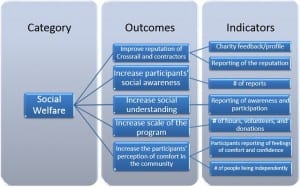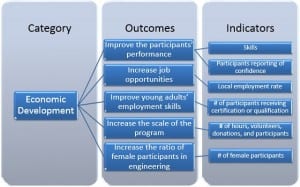Crossrail Community Investment Program
| Sponsor: | Crossrail Ltd. |  |
| Sponsor Liaison: | Shireen Ali-Khan | |
| Student Team: | William Evangelakos, Sean Greene, Yi Sun, | |
| Abstract: | Crossrail aims to bring a new world-class railway to the London area. It requires its contractors to deliver Community Investment Programs (CIPs) to give back to the communities in which they work. Our goal was to develop an assessment system to evaluate the impact of CIPs on local communities. We conducted research in several boroughs affected by CIPs in order to understand the needs of the community. We interviewed contractors and a local governmental official, surveyed community members, and engaged in on-going CIPs. After collecting and analyzing our data, we classified CIPs into four categories, and identified potential outcomes and indicators to assess the impact of CIPs on communities. | |
| Link: | CrossrailCommunityInvestmentPogramE2014IQP | |
Executive Summary
Introduction
The Crossrail Community Investment Program (CIP), a long-term initiative to support local communities, is one of the sub-programs under Crossrail. The CIP is the first of its kind in the United Kingdom. According to the Crossrail website, “It requires Crossrail construction contractors to donate their time, money and expertise to bring lasting benefits to the communities in which they are working” (Crossrail Ltd, 2014). Crossrail has implemented Community Investment Programs alongside the construction to deliver consistent and meaningful benefits.
While good intentions have given these ideas momentum, there have been few standardized or consistent sets of updated and specific tools or strategies to assess the Community Investment Programs’ design or delivery. Crossrail was looking to efficiently evaluate the effectiveness of their Community Investment Programs in order to create long-lasting positive projects in the community. Without a systematic way to evaluate these initiatives, some Community Investment Programs suffer from limited ingenuity and funding, and contractors are frustrated by the lack of recognition that they receive for their efforts. Our goal is to establish benchmarks for systematically evaluating the impacts of each project on their local communities. A rubric that can measure outcomes can assist the contractors and planners in realizing how these projects have and can still benefit the quality of life of local residents.
Literature Review
|
Figure 1. Crossrail CIP Initiatives Map (Crossrail Ltd, 2014) |
We investigated current Crossrail Community Investment Programs, as well as two related case studies. As we have stated, the CIP was conceived as a series of sub-projects that could support initiatives in local communities. More than 20 different projects have already been designated and put into practice in eight communities: Westminster, Islington, Hackney, Newham, Greenwich, Tower Hamlets, Kensington & Chelsea, and Hammersmith & Fulham. The Crossrail CIP Initiatives Map in Figure 1 depicts the kinds of projects that have been completed in the respective boroughs.
We investigated the concept of Corporate Social Responsibility and essential social values behind the community investment, as well as a successful community investment completed by Cisco, an American computer networks company. With an insightful investment, Cisco provided communities and local residents with more educational opportunities and jobs, and further developed the economies of these communities.
Indicators and measures for community impact have been used in other similar case studies. In general, indicators should clarify the outcomes and make them either observable or measurable (Community Stabilization Report, 2014).
We also analyzed a comparative case study between the UK and Australia on outsourcing community services to non-profited organizations or sectors – an unsuccessful management of the Community Investment Program. This case study allowed us to see the role that different quantitative and qualitative indicators play, and what can potentially cause the failure of providing sustainable and long-lasting community investments.
Methodology
The main goal of our project was to develop a new assessment system to evaluate the impacts of the Crossrail CIP on local communities, and to encourage more of Crossrail’s contractors and employees to design and deliver successful CIP in the future. Therefore, we had four objectives for the successful completion of our goal:
1. Identify and evaluate five communities that have been already affected by Community Investment Programs in terms of their environment and their collaborative relationship with the local contractors.
2. Understand the experiences of contractors engaged in Community Investment Programs including the challenges that they faced and the motivation they had while designing and delivering their Community Investment Programs.
3. Understand the expectations of local residents and people who were influenced by Community Investment Programs in order to recognize the areas in which community engagement can be improved.
4. Discover the potential outcomes and compile a set of corresponding indicators that can be used to create an evaluation tool for Community Investment Programs and contractors.
Upon commencing work at Crossrail, we conducted archival research on the populations and demographics of each borough associated with Crossrail according to the London 2011 census in order to develop a better understanding of the status of each borough and the economic standings of its residents. We visited eight different construction sites: Paddington, Whitechapel, Tottenham Court Road, Liverpool Street, Bond Street, Woolwich, Victoria Dock Road, and Wallasea Island. We completed a site assessment checklist for five of these communities. We also developed an online survey for two hundred contractors and employees, as well as an interview guide for the face-to-face interviews with six contractors. Furthermore, we designed and conducted paper surveys for the residents in the community affected by Crossrail and its CIPs in order to understand the residents’ perspective on these programs. We then divided CIPs into different categories according to their inputs and outcomes, and then compiled a set of corresponding indicators to evaluate each of these categories.
Results and Discussions
Based on the 6 interviews, 9 paper survey responses, and 139 online survey responses, we can determine that Community Investment Programs can actually mitigate some of the negative effects that the construction might have on the local community, and also change local residents’ perspective towards Crossrail. Key words, such as “legacy” and “long-term,” appeared several times from responses of contractors, residents, and the local governmental official. Community Investment Programs involved in job training, youth employment, and early childhood development were recommended most for future programs. All of the results from our surveys to the residents reflect the four main aspects for future Community Investment Programing: education, renovation, social welfare, and economic development. These four categories are the most significant areas that need to be improved and addressed. Currently most of Crossrail contractors and employees have developed a good understanding of the Community Investment Programs. However, our team was surprised by the limited awareness of the Community Investment Program among local residents based on the responses from our paper survey.
From the interviews, we found that most contractors have not actively sought feedback from volunteers and participants. However, data from the online survey shows that people would like to see the outcomes and learn more about the Community Investment Programs from Internal Communications and the Crossrail website. Therefore, it was clear that an assessment system that makes explicit potential outcomes of programs in different dimensions and that provides indicators was needed.
Previous Crossrail Community Investment Programs have covered a wide range of areas. By dividing them into education, renovation, social welfare, and economic development categories we were able to identify both quantitative and qualitative indicators appropriate for each category. These indicators provide an effective mechanism that Crossrail, the contractors, and the local communities can utilize to assess the impact of their Community Investment Programs.
Recommendations and Conclusions
We recommend that each Community Investment Program implemented by a Crossrail Contractor follow the core mission established by the initiative to be sustainable, long lasting, and provide a legacy to the community. More specifically, we recommend that Crossrail and contractors divide Community Investment Programs into four categories: education, renovation and refurbishment, social welfare, and economic development. We recommend that Crossrail and contractors be required to track the inputs of their Community Investment Programs, and that they also track the outcomes and indicators related to their Community Investment Program according to its category. See Figures 2, 3, 4, and 5 for category-specific outcomes and indicators for the education, renovation and refurbishment, social welfare, and economic development categories, respectively.
Figure 2. Education CIP Outcomes and Indicators
Figure 3. Renovation and Refurbishment CIP Outcomes and Indicators
Figure 4. Social Welfare CIP Outcomes and Indicators
Figure 5. Economic Development CIP Outcomes and Indicators
We recommend that all new Crossrail contractors should fill out a site assessment checklist to gain a deep understanding of the community’s background and needs. Additionally, all Crossrail contractors should establish goals and predict potential outcomes before delivery, track outcomes during the program, and document all accomplishments and results after completion. Finally, all Crossrail contractors should access the CIP webpage to get a comprehensive understanding of the indicators and evaluation methods in each category.
In conclusion, with the recommended assessment system that includes these comprehensive indicators and outcomes in place, the efficiency and effectiveness of the CIP evaluation process will be greatly improved. More contractors and employees will be encouraged to participate in the program. We expect that these recommendations will enhance Crossrail’s ability to offset the negative consequences of construction with meaningful, sustainable, and long-lasting Community Investment Programs.







